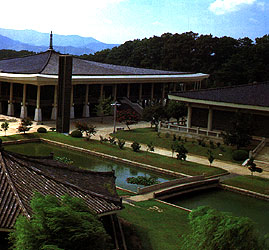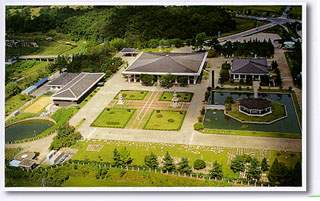
Gyeongju National Museum is the essence of the Silla culture in general
with 2,500 artifacts including the prehistoric relics and the Buddhist
artifacts on display and 80,000 in storage.
In 1910 a group of Gyeongju
residents formed the Silla Gyeongju Society in an effort to preserve
historic sites and relics in and around Gyeongju. It was expanded
and renamed the Gyeongju Historical Association in 1913 at which
time it made an old Joseon period government guest house into an
exhibition hall for displaying relics.
In 1921 Gyeongju began to attract both domestic and international
attention when a gold crown and many other relics were discovered
during the excavation of a royal tomb, which was later named Gumgwanchong
Tomb, meaning Gold Crown Tomb. From that time, the exhibition hall
was used to display relics from the tomb and began to be called
Gumgwan-go, meaning Gold Crown Hall.
It became the Gyeongju
Branch of the Japanese Colonial Government Museum in 1926. With
Korea's independence in 1945, the Museum was reorganized as the
Gyeongju Branch of the National Museum.
Because of the growing number of historic relics and artifacts excavated
in the Gyongju area, new museum facilities including a main building
and an annex were constructed on a 66,000 square meter area in 1975.
At that time, the museum status was elevated and it was named the
Gyeongju National Museum. A second annex building was opened in
1895 to display relics recovered during the excavation of Anapji
Pond.
The museum consists of the main building, Annex
1 and Annex 2. Over 80,000 artifacts and relics are kept in the
museum, but only 2,500 items or so are on constant display. The
main building consists of three exhibition rooms. Artifacts from
Prehistoric to Proto-Three Kingdoms Period are exhibited in Prehistoric
& Proto-Three Kingdoms Room; sculptures, tiles, metal crafts,
and stone monuments are exhibited in the Arts & Crafts Room
and artifact donated from Dr. Lee Yangseon are exhibited in the
Gugun Collection.

|